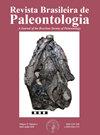物理术语:Parasuchia, Phytosauria还是Belodontia?
IF 0.6
4区 地球科学
Q4 PALEONTOLOGY
引用次数: 1
摘要
本文根据《国际动物命名法》对植龙的命名状况进行了分析。过去,一些作者将其解释为一个科群和/或一个属群名称,但这些方法在法典的一些条款中都失败了。Jæger植物龙在这里被解释为最初是为一个集体而建立的,不能作为二分类学的名义属,但优先于任何其他更年轻的同音词,第一个可用的是Wagler植物龙。基于Wagler植物龙的类群名Phytosauria Baur和科群名Phytosauridae Lydekker作为无效的初级同音异义,最终被否决。相反,类群名称Parasuchia Huxley和Belodontia Brauns以及科群名称Belodontidae Cope更古老,但与Belodon plieningeri Meyer有一些分类限制。为了避免给旧的植物恐龙取新名字,修复植物恐龙高阶命名法的解决方案是为Belodon plieningeri Meyer指定一个新种。关键词:副龙目,植龙目,齿龙目,始龙目,三叠纪,集体群本文章由计算机程序翻译,如有差异,请以英文原文为准。
Phytosaurian Nomenclature: Parasuchia, Phytosauria or Belodontia?
The nomenclatural status of Phytosaurus Jæger is here analyzed in accordance with the International Code of Zoological Nomenclature. In the past, several authors have interpreted it as both a family-group and/or a genus-group name, but each of these approaches fails in several articles of the Code. Phytosaurus Jæger is here interpreted as originally established for a collective-group and cannot be used as a nominal genus in binomina, but takes precedence over any other younger homonym, and the first available one is Phytosaurus Wagler. Being an invalid junior homonym, the class-group name Phytosauria Baur and the family-group name Phytosauridae Lydekker, which are based on Phytosaurus Wagler, are ultimately rejected. Conversely, the class-group names Parasuchia Huxley and Belodontia Brauns, as well as the family-group name Belodontidae Cope, are older but have some taxonomic restrictions in relation to Belodon plieningeri Meyer. To avoid proposing new names for old ones, the solution to fix the higher-order nomenclature for phytosaurs is to designate a neotype for Belodon plieningeri Meyer. Keywords: Parasuchia, Phytosauria, Belodontia, Archosauriformes, Triassic, collective-group.
求助全文
通过发布文献求助,成功后即可免费获取论文全文。
去求助
来源期刊

Revista Brasileira De Paleontologia
PALEONTOLOGY-
CiteScore
1.60
自引率
14.30%
发文量
25
审稿时长
>12 weeks
期刊介绍:
It publishes original contributions on all aspects of Paleontology. Papers are written in English, Spanish, or Portuguese and are reviewed by international experts.
 求助内容:
求助内容: 应助结果提醒方式:
应助结果提醒方式:


